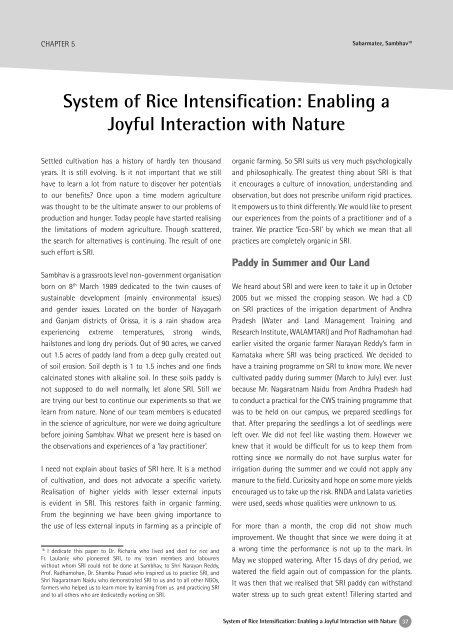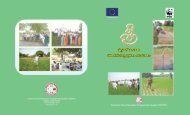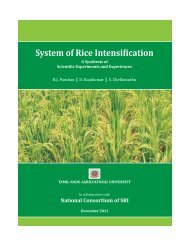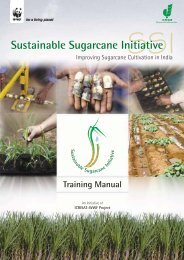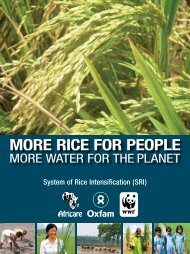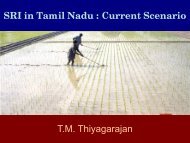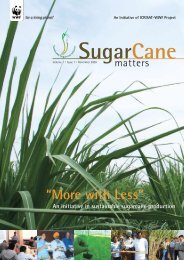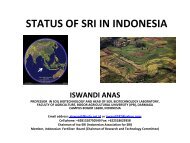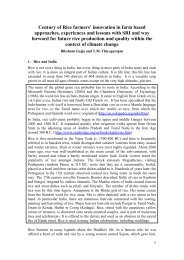SRI in Orissa - Cornell International Institute for Food, Agriculture ...
SRI in Orissa - Cornell International Institute for Food, Agriculture ...
SRI in Orissa - Cornell International Institute for Food, Agriculture ...
You also want an ePaper? Increase the reach of your titles
YUMPU automatically turns print PDFs into web optimized ePapers that Google loves.
CHAPTER 5<br />
Sabarmatee, Sambhav 18<br />
System of Rice Intensification: Enabl<strong>in</strong>g a<br />
Joyful Interaction with Nature<br />
Settled cultivation has a history of hardly ten thousand<br />
years. It is still evolv<strong>in</strong>g. Is it not important that we still<br />
have to learn a lot from nature to discover her potentials<br />
to our benefits? Once upon a time modern agriculture<br />
was thought to be the ultimate answer to our problems of<br />
production and hunger. Today people have started realis<strong>in</strong>g<br />
the limitations of modern agriculture. Though scattered,<br />
the search <strong>for</strong> alternatives is cont<strong>in</strong>u<strong>in</strong>g. The result of one<br />
such ef<strong>for</strong>t is <strong>SRI</strong>.<br />
Sambhav is a grassroots level non-government organisation<br />
born on 8 th March 1989 dedicated to the tw<strong>in</strong> causes of<br />
susta<strong>in</strong>able development (ma<strong>in</strong>ly environmental issues)<br />
and gender issues. Located on the border of Nayagarh<br />
and Ganjam districts of <strong>Orissa</strong>, it is a ra<strong>in</strong> shadow area<br />
experienc<strong>in</strong>g extreme temperatures, strong w<strong>in</strong>ds,<br />
hailstones and long dry periods. Out of 90 acres, we carved<br />
out 1.5 acres of paddy land from a deep gully created out<br />
of soil erosion. Soil depth is 1 to 1.5 <strong>in</strong>ches and one f<strong>in</strong>ds<br />
calc<strong>in</strong>ated stones with alkal<strong>in</strong>e soil. In these soils paddy is<br />
not supposed to do well normally, let alone <strong>SRI</strong>. Still we<br />
are try<strong>in</strong>g our best to cont<strong>in</strong>ue our experiments so that we<br />
learn from nature. None of our team members is educated<br />
<strong>in</strong> the science of agriculture, nor were we do<strong>in</strong>g agriculture<br />
be<strong>for</strong>e jo<strong>in</strong><strong>in</strong>g Sambhav. What we present here is based on<br />
the observations and experiences of a ‘lay practitioner’.<br />
I need not expla<strong>in</strong> about basics of <strong>SRI</strong> here. It is a method<br />
of cultivation, and does not advocate a specific variety.<br />
Realisation of higher yields with lesser external <strong>in</strong>puts<br />
is evident <strong>in</strong> <strong>SRI</strong>. This restores faith <strong>in</strong> organic farm<strong>in</strong>g.<br />
From the beg<strong>in</strong>n<strong>in</strong>g we have been giv<strong>in</strong>g importance to<br />
the use of less external <strong>in</strong>puts <strong>in</strong> farm<strong>in</strong>g as a pr<strong>in</strong>ciple of<br />
18<br />
I dedicate this paper to Dr. Richaria who lived and died <strong>for</strong> rice and<br />
Fr. Laulanie who pioneered <strong>SRI</strong>, to my team members and labourers<br />
without whom <strong>SRI</strong> could not be done at Sambhav, to Shri Narayan Reddy,<br />
Prof. Radhamohan, Dr. Shambu Prasad who <strong>in</strong>spired us to practice <strong>SRI</strong>, and<br />
Shri Nagaratnam Naidu who demonstrated <strong>SRI</strong> to us and to all other NGOs,<br />
farmers who helped us to learn more by learn<strong>in</strong>g from us and practic<strong>in</strong>g <strong>SRI</strong><br />
and to all others who are dedicatedly work<strong>in</strong>g on <strong>SRI</strong>.<br />
organic farm<strong>in</strong>g. So <strong>SRI</strong> suits us very much psychologically<br />
and philosophically. The greatest th<strong>in</strong>g about <strong>SRI</strong> is that<br />
it encourages a culture of <strong>in</strong>novation, understand<strong>in</strong>g and<br />
observation, but does not prescribe uni<strong>for</strong>m rigid practices.<br />
It empowers us to th<strong>in</strong>k differently. We would like to present<br />
our experiences from the po<strong>in</strong>ts of a practitioner and of a<br />
tra<strong>in</strong>er. We practice ‘Eco-<strong>SRI</strong>’ by which we mean that all<br />
practices are completely organic <strong>in</strong> <strong>SRI</strong>.<br />
Paddy <strong>in</strong> Summer and Our Land<br />
We heard about <strong>SRI</strong> and were keen to take it up <strong>in</strong> October<br />
2005 but we missed the cropp<strong>in</strong>g season. We had a CD<br />
on <strong>SRI</strong> practices of the irrigation department of Andhra<br />
Pradesh (Water and Land Management Tra<strong>in</strong><strong>in</strong>g and<br />
Research <strong>Institute</strong>, WALAMTARI) and Prof Radhamohan had<br />
earlier visited the organic farmer Narayan Reddy’s farm <strong>in</strong><br />
Karnataka where <strong>SRI</strong> was be<strong>in</strong>g practiced. We decided to<br />
have a tra<strong>in</strong><strong>in</strong>g programme on <strong>SRI</strong> to know more. We never<br />
cultivated paddy dur<strong>in</strong>g summer (March to July) ever. Just<br />
because Mr. Nagaratnam Naidu from Andhra Pradesh had<br />
to conduct a practical <strong>for</strong> the CWS tra<strong>in</strong><strong>in</strong>g programme that<br />
was to be held on our campus, we prepared seedl<strong>in</strong>gs <strong>for</strong><br />
that. After prepar<strong>in</strong>g the seedl<strong>in</strong>gs a lot of seedl<strong>in</strong>gs were<br />
left over. We did not feel like wast<strong>in</strong>g them. However we<br />
knew that it would be difficult <strong>for</strong> us to keep them from<br />
rott<strong>in</strong>g s<strong>in</strong>ce we normally do not have surplus water <strong>for</strong><br />
irrigation dur<strong>in</strong>g the summer and we could not apply any<br />
manure to the field. Curiosity and hope on some more yields<br />
encouraged us to take up the risk. RNDA and Lalata varieties<br />
were used, seeds whose qualities were unknown to us.<br />
For more than a month, the crop did not show much<br />
improvement. We thought that s<strong>in</strong>ce we were do<strong>in</strong>g it at<br />
a wrong time the per<strong>for</strong>mance is not up to the mark. In<br />
May we stopped water<strong>in</strong>g. After 15 days of dry period, we<br />
watered the field aga<strong>in</strong> out of compassion <strong>for</strong> the plants.<br />
It was then that we realised that <strong>SRI</strong> paddy can withstand<br />
water stress up to such great extent! Tiller<strong>in</strong>g started and<br />
System of Rice Intensification: Enabl<strong>in</strong>g a Joyful Interaction with Nature 37


